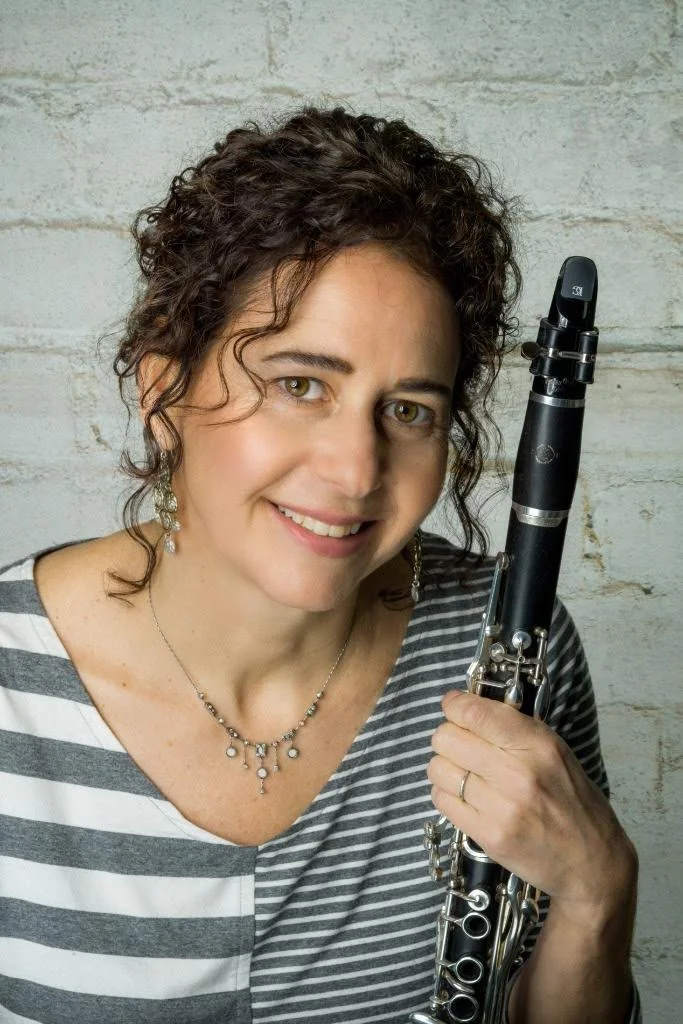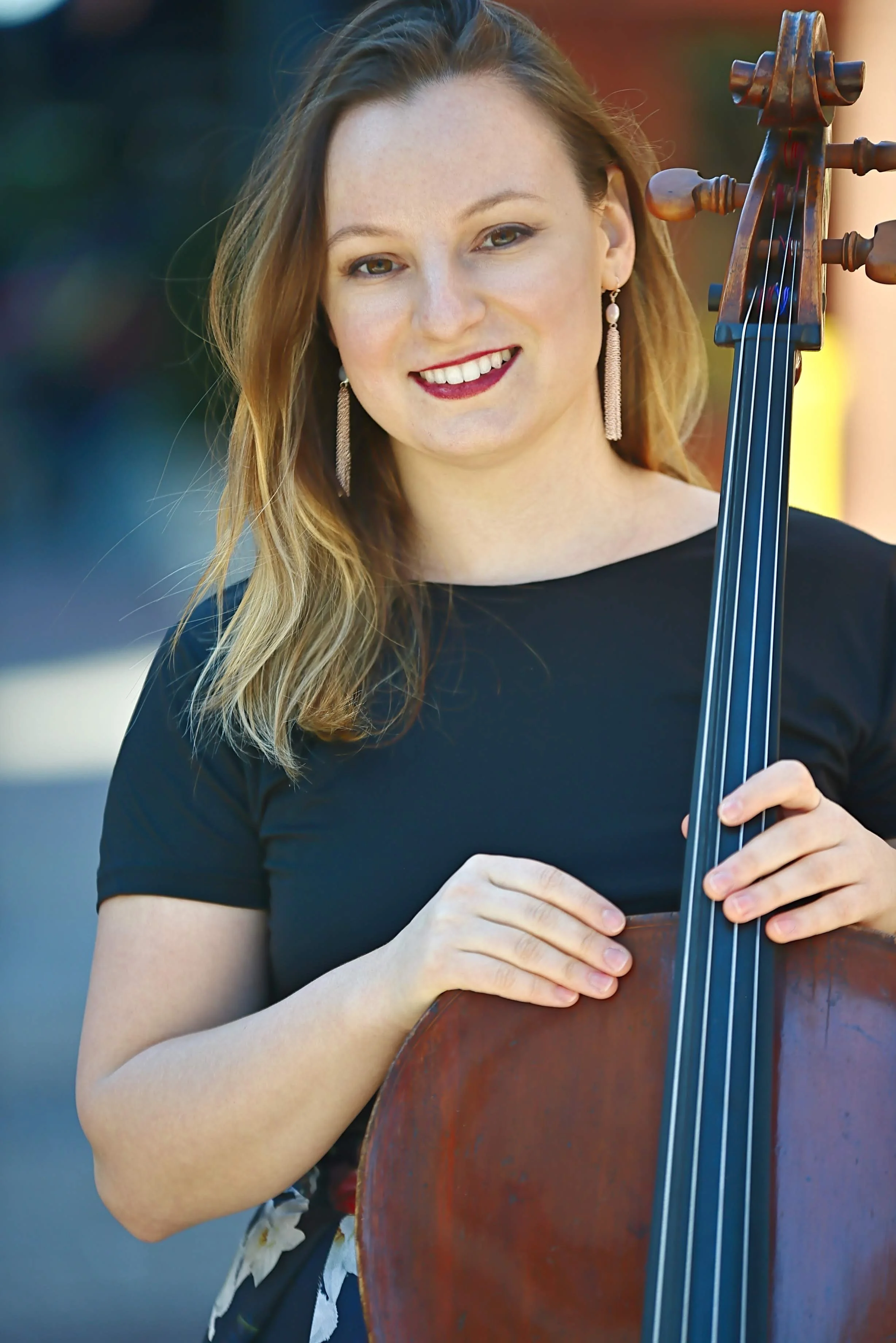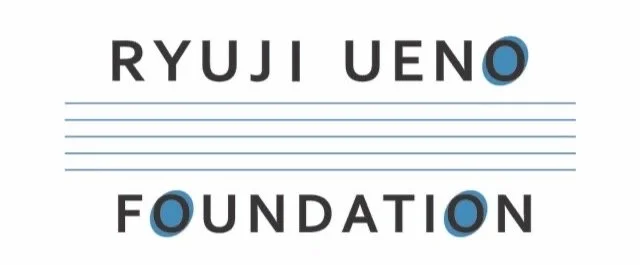Eroica Rising:
Celebrating
Women's Heroic Journey
New Orchestra of Washington presents
Eroica Rising: Celebrating Women's Heroic Journey
Alejandro Hernandez-Valdez, conductor
Valeriya Sholokhova, cellist
Jo-Ann Sternberg, clarinetist
Friday, November 15 | 7:30 PM
The John F. Kennedy Center for the Performing Arts Terrace Theater
2700 F St., NW, Washington, DC 20566
-
"Becoming" is the process of growth, unfolding who we are meant to be. By definition, the meaning of “becoming” is rooted in resilience, strength, and courage, because it acknowledges that the current state is not where one is meant to be yet.
In the process of “becoming,” we are often faced with a journey of “overcoming” as we draw the strength to rise beyond obstacles, to transform and transcend. Tonight’s concert is a tribute to this journey, an exploration of becoming and overcoming woven through the unique voices and styles of three masterworks.
We begin with Camille Pépin’s The Sound of Trees, a meditation on resilience. Pépin’s music captures the quiet power of the natural world, inviting us to feel the strength rooted deep within, as if each tree stands as a witness to time, weathering storms but always growing upward. Her music reminds us that the journey to becoming begins with grounded strength, unseen but unyielding.
Joan Tower’s Made in America brings us to a different stage of the journey — the struggle to assert identity and purpose amid challenges. Through Tower’s piece, we hear the story of overcoming, of navigating a complex identity and weaving together a tapestry of both conflict and unity. Her music resonates with the voices of women who have faced adversity and pushed forward, drawing from a resilience born of necessity and unshakable hope.
Finally, we conclude with Beethoven’s Eroica Symphony, a work originally dedicated to ideals of heroism and defiance, embodying the ultimate triumph over adversity. Though composed by a man, Eroica serves as a powerful tribute to the courage it takes to break new ground, to stand boldly against limitations, and to champion ideals greater than oneself. Perhaps, in this symphony, the true hero is Beethoven himself — becoming, overcoming, and ultimately rising through an artistic triumph over the profound challenge of his encroaching deafness.
Tonight’s program honors the journey that each of us undertakes and the courage it demands. Let us remember that this journey is still ongoing, that the stories of becoming and overcoming will continue to inspire us all to reach for more, to stand together, and to rise.
—Grace Cho, Executive Director
Program
CAMILLE PÉPIN (b. 1990) The Sound of Trees
Paisible, boisé
Plus luineux, irisé
Céleste, planant
Entétant - Tournoyant, hypnotique
Apaisé, boisé
Featuring Valeriya Sholokhova, cello and Jo-Ann Sternberg, clarinet
-
Combining solo clarinet and cello with a symphony orchestra, The Sound of Trees was written to a commission from the Orchestre de Picardie. Is it a double concerto? The term is not the best adapted: Camille Pépin moves away from traditional concertante mechanisms to cultivate a subtle play of timbres rooted in the orchestra, taking advantage of the soloists' presence to give original relief to the symphonic whole. The clarinet and cello regularly blend into the instrumental landscape before coming back to the foreground, sometimes triggering the echo of one or two sections and giving depth and movement to the orchestral mass. Only in the central cadenza do the soloists escape in tandem in an acrobatic passage that follows the virtuosic logic of concertos.
This duo also suddenly recalls the preponderant place occupied by the cello and clarinet in Camille Pépin's chamber music catalogue (Luna, Kono Hana, Snow, Moon & Flowers). With their velvety breath and woody matter, the two instruments were already well installed in the composer's poetic universe. As soon as she received the commission for the present work, and even before sketching the first notes, Camille Pépin naturally made the connection between the two solo timbres and a poem by Robert Frost which had left a particular impression on her. In The Sound of Trees, the American poet hears the call to travel thrown out by the bewitching rustling of the immobile trees, 'till we lose all measure of pace'. And Camille Pépin transposes this evocation into an animated instrumental canvas, rich in various instrumental grains and yet stabilised by founding motifs and textures.
Fascinated by Debussy's music in general and La Mer in particular, the composer, like her elder, takes inspiration from a poeticized Nature to find the substance of a meticulous orchestration. Reminiscent of Debussy's symphonic sketches, the opening notes of The Sound of Trees progressively emerge from the blank page: soon animated by misty rhythms, a single note makes itself heard amongst the sections, then a second, before a tetratonic motif blossoms in the clarinet. Camille Pépin then leaves the Debussyst paths to lose the listener in her forest of timbres. No real theme structures a discourse that seems to engender itself with a gripping illusion of freedom. Only mobile motifs rock above captivating ostinatos, with these insistent variations that make her the composer Steve Reich's French spiritual heiress. Despite the variety of rhythmic vivacity creating the impression of three different movements, the musical flow is uninterrupted - as often with Camille Pépin - and irresistibly comes back to its starting point, closing the framework of the sound landscape.
—Camille Pépin
JOAN TOWER (b. 1938) Made in America
-
I crossed a fairly big bridge at the age of nine when my family moved to South America (La Paz, Bolivia), where we stayed for nine years. I had to learn a new language, a new culture, and how to live at 13,000 feet! It was a lively culture with many saints' days celebrated through music and dance, but the large Inca population in Bolivia was generally poor and there was little chance of moving up in class or work position.
When I returned to the United States, I was proud to have free choices, upward mobility, and the chance to try to become who I wanted to be. I also enjoyed the basic luxuries of an American citizen that we so often take for granted: hot running water, blankets for the cold winters, floors that are not made of dirt, and easy modes of transportation, among many other things. So when I started composing this piece, the song "America the Beautiful" kept coming into my consciousness and eventually became the main theme for the work. The beauty of the song is undeniable and I loved working with it as a musical idea. One can never take for granted, however, the strength of a musical idea — as Beethoven (one of my strongest influences) knew so well. This theme is challenged by other more aggressive and dissonant ideas that keep interrupting, unsettling it, but "America the Beautiful" keeps resurfacing in different guises (some small and tender, others big and magnanimous), as if to say, "I'm still here, ever changing, but holding my own." A musical struggle is heard throughout the work. Perhaps it was my unconscious reacting to the challenge of how do we keep America beautiful.
—Joan Tower
Intermission (15 minutes)
BEETHOVEN (1770-1827) Eroica Symphony
Allegro con brio
Marcia funebre: Adagio assai
Scherzo: Allegro vivace
Finale: Allegro molto
-
I must live like an exile. In company I am assailed by the most painful apprehensions, from the dread of being exposed to the risk of my condition being observed. It was the same during the last six months I spent in the country. My intelligent physician recommended me to spare my hearing as much as possible, which was quite in accordance with my present disposition, though sometimes, tempted by my natural inclination for society, I allowed myself to be beguiled into it. But what humiliation when any one beside me heard a flute in the far distance, while I heard nothing, or when others heard a shepherd singing, and I still heard nothing! Such things brought me to the verge of desperation, and well-nigh caused me to put an end to my life. Art! art alone deterred me. Ah! how could I possibly quit the world before bringing forth all that I felt it was my vocation to produce? And thus I spared this miserable life — so utterly miserable that any sudden change may reduce me at any moment from my best condition into the worst. It is decreed that I must now choose Patience for my guide!
— Ludwig van Beethoven, from the Heiligenstadt Testament, written in 1802 as he was formulating Symphony No. 3
Meet the Artists
-
Esteemed conductor and pianist Dr. Alejandro Hernandez-Valdez is Artistic Director of Musica Viva NY and Director of Music at the historic Unitarian Church of All Souls in Manhattan. He is also Artistic Director and co-founder of the New Orchestra of Washington, and Artistic Director of the Victoria Bach Festival. He has earned accolades from The Washington Post as a conductor “with the incisive clarity of someone born to the idiom,” as well as praise from The New York Times for leading “a stirring performance” of Brahms’ Ein Deutsches Requiem. At a concert commemorating the 100th Anniversary of the WWI Armistice (featuring the world premiere of Joseph Turrin’s cantata, And Crimson Roses Once Again Be Fair) Oberon’s Grove wrote: “Maestro Alejandro Hernandez-Valdez drew rich, warm sounds from the musicians” in “a beautiful and deeply moving program.” He is featured in El mundo en las manos/Creadores mexicanos en el extranjero (The World in Their Hands/Creative Mexicans Abroad), a book by the Mexican Ministry of Foreign Affairs honoring Mexican nationals who are leading figures in diverse artistic fields. He is the recipient of a 2016 Shenandoah Conservatory Alumni of Excellence Award for his exemplary contribution to his profession, national level of prominence, and exceptional integrity. He resides in New York City.
In 2016, during its 40th anniversary season, Hernandez-Valdez was named the third Artistic Director of the Victoria Bach Festival in Texas. As Mike Greenberg wrote in Classical Voice America: “A big question mark hung over the venerable Victoria Bach Festival two years ago when the brilliant Craig Hella Johnson, its artistic director since 1992, decided to give up the post…Johnson’s successor has replaced the question mark with an exclamation point — perhaps more appropriately, given his Spanish name and Mexican provenance, two exclamation points: ¡Alejandro Hernandez-Valdez!” “The results,” Greenberg continued, “were astonishing.”
Founded in 1977, Musica Viva NY was recently praised by The New York Times as “an excellent chorus.” The ensemble has a longstanding tradition of top-caliber performances, innovative programming, and a strong dedication to the commissioning of new music. Its alumni include Renée Fleming, Samuel Ramey, and Michael Maliakel. Since taking the helm at Musica Viva NY in 2015, Hernandez-Valdez has presented an exceptionally broad and innovative repertoire in each of the choir’s seasons, engaging and inspiring audiences with remarkable interpretations of familiar and new works, and exploring the acoustical capabilities of the historic sanctuary of All Souls Church and other venues on Manhattan’s Upper East Side.
As the Artistic Director and co-founder of the New Orchestra of Washington (NOW), a chamber orchestra that “has constituted itself in the forefront of this smaller-is-better movement” (The Washington Post), Hernandez-Valdez has been reimagining for the past ten years what have been the limited definitions of “classical music.” NOW’s innovative programming and creative approach to music performance continues to reshape and enrich the cultural landscape of the National Capital Region.
A passionate advocate of new music, Hernandez-Valdez has commissioned and premiered works by Joan Tower, Arturo Márquez, Joseph Turrin, Gilda Lyons, Seymour Bernstein, Viet Cuong, Juan Pablo Contreras, Elena Ruehr, Ramzi Aburedwan, Jorge Vidales, Mokale Koapeng, Trent Johnson, Javier Farias, Andrés Levell, Zachary Wadsworth, Martin Spruijt, Joel Friedman, and other notable composers.
Hernandez-Valdez’s guest conducting engagements include appearances at The Kennedy Center in Washington, D.C., Lincoln Center in New York City, and the historic Degollado Theatre in Guadalajara, Mexico, where he has directed the Jalisco Philharmonic. As a pianist, Hernandez-Valdez performed for the 2013 Britten100 festival in New York City, organized by the Britten-Pears Foundation to honor the 100th anniversary of the titular composer’s birth. As a composer and conductor, he led the premiere of his own composition, The Imaginary City, a cantata inspired by the life of Ramzi Aburedwan, a violist who has opened schools throughout Palestine to teach music to children in refugee camps. He also arranged and premiered the chamber orchestra version of A Song of Nature by Seymour Bernstein. Mr. Bernstein, the subject of Ethan Hawke’s 2014 documentary film, Seymour: An Introduction, is one of Hernandez-Valdez’s most influential teachers and mentors.
-
Ukrainian-American cellist Valeriya Sholokhova is an in-demand soloist and chamber musician based in New York City. She has performed on renowned stages such as Carnegie Hall, Wigmore Hall, David Geffen Hall, The Kennedy Center, the Metropolitan Museum, and Saturday Night Live. Valeriya has toured extensively across Europe, with performances in Denmark, Austria, Croatia, Poland, the Baltic States, Sweden, Germany, and Ukraine. In 2022, she co-founded Trio Fadolin, an ensemble exploring the unique sound of the six-string fadolin. The trio has since received Chamber Music America’s Ensemble Forward Grant and recorded an album of newly commissioned works.
Valeriya is a laureate of several international competitions, including the Liezen International Cello Competition and the Antonio Janigro Competition. She has served as principal cellist at notable festival orchestras such as Spoleto Festival USA, Orchestra of the Americas, the Perlman Music Program, Music Academy of the West, and Thy Music Festival in Denmark. Currently, she holds principal cello positions with The New Orchestra of Washington, The Refugee Orchestra Project, The Washington Heights Chamber Orchestra, and is on the Lincoln Center Stage roster. In 2021, Valeriya performed the U.S. premiere of Peteris Vasks’ Cello Concerto No. 2 in Boston, alongside members of the Boston Philharmonic.
Born in Kyiv, Ukraine, Valeriya graduated from The Juilliard School and Manhattan School of Music, where she studied on full scholarship with Bonnie Hampton and David Geber. She also pursued studies at the Royal Danish Academy of Music under Professor Morten Zeuthen. In addition to her performing career, Valeriya is dedicated to community outreach, regularly performing through Sing for Hope at hospitals, nursing homes, and correctional facilities.
-
Clarinetist Jo-Ann Sternberg leads a diverse musical life in the New York area as a chamber musician, orchestral player, music educator, and interpreter of new music. Jo-Ann is a member of the Borealis Wind Quintet, the Richardson Chamber Players, the Saratoga Chamber Players, Wind Soloists of New York, and the Riverside Symphony; principal clarinet of the orchestras of the Oratorio Society of NY, the NY Choral Society, and St. John the Divine; and she has regularly performed and toured with Orpheus Chamber Orchestra, the American Composers Orchestra, Mark Morris Dance, the American Symphony, the Chamber Music Society of Lincoln Center, Musicians from Marlboro, and a number of Broadway musicals.
Following her undergraduate years in the combined Tufts University/New England Conservatory dual degree program (BA in English/BM in Clarinet Performance) where she was mentored by Peter Hadcock, Ms. Sternberg continued her studies at Yale University with David Shifrin and at The Juilliard School with Charles Neidich where she was awarded the William Kapell Memorial Award. Currently, Ms. Sternberg serves on the faculties of Princeton University, Rutgers Mason Gross School of Music, and the Music Advancement Program at the Juilliard School; she also maintains an active teaching studio from her New York City home. Additionally, she serves as a mentor for the Juilliard Mentoring Program and is a coach for the New York Youth Symphony.
In the summer months, Ms. Sternberg lives in Maine where she is the Founder and Artistic Director of The Maine Chamber Music Seminar at Snow Pond for college and graduate-level musicians. She also performs and teaches at the Chamber Music Conference & Composers’ Forum of the East, and participates in numerous performance residences throughout greater New England. Previous summers have featured performance residencies at the Portland Chamber Music Festival, Salt Bay ChamberFest, Mount Desert Chamber Music Festival, Sebago/Long Lake Festival, Bowdoin Summer Music Festival, Marlboro, Norfolk, North Country Chamber Players, and Ravinia.
From September through May, Jo-Ann resides in NYC with her family. Ms. Sternberg is a Selmer Artist.
-
Violin I
Akemi Takayama, concertmaster
Chaeyoung Yeom
Rachel Lee Zhao
Matt Richardson
Sherri Zhang
Charles CleasonViolin II
Sergey Prokofyev, principal
Nancy Jin
Milena Aradski
Eva Cappelletti Chao
Mia LeeViola
Greg Luce, principal
Ivan Mendoza
Cameron Raecke
Stanley BeckwithCello
Valeriya Sholokhova, principal
Tobias Werner
Nick PascucciDouble Bass
Chris Chlumsky, principal
Jessica EigFlute and Piccolo
Conor Nelson, principal
Rachel WoolfOboe
Stephen Key, principal
Luis GutierrezClarinet
Kathy Mulcahy, principal
Jacob MoyerBassoon
Eddie Sanders, principal
Jimmy RenFrench Horn
Shona Goldberg-Leopold, principal
Chandra Cervantes
Patrick Furlo
Justin DrewTrumpet
Chris Carrillo, principal
John AbbracciamentoTrombone
David Perkel, principalPercussion and Timpani
David Constantine, principal
Jeffrey GrantCelesta and Piano
Grace Cho
New Orchestra of Washington
-
Reimagining what have been the limited definitions of “classical music,” the New Orchestra of Washington (NOW) welcomes audiences into a transformative musical experience that lessens the distance between our identities and compels listeners to feel something in the sound.
We create what we call “great music without labels.” It represents the robust cultural and ethnic diversity in metropolitan Washington, DC, where we’re intentional about making orchestral music beautiful and accessible to people from all backgrounds. Our hallmark is small, intimate performances that put audiences at the heart center of musicians who pour the best of themselves and their cultures into immersive concerts that leave attendees inspired.
NOW is guided by six values—collaboration, representation, education, access, technology and experimentation (CREATE)—to foster innovative, inclusive programming; nurture enriching partnerships; and infuse the global flavors of all music. We lead with love for the experiential music we create and, most important, the people we want to absorb it.
Our Mission: to make transformative musical experiences available and accessible to all people.
-
Officers
Tom Patton, Chair
Paul Connor, TreasurerBoard Members
Morris Deutsch
Rachel Dougan
Louise Harkavy
Dianne Peterson
Ryuji Ueno
Sinclair Vincent
Ann Yonemura
Grace Cho, ex-officio
Alejandro Hernandez-Valdez, ex-officio -
Alejandro Hernandez-Valdez, Artistic Director
Grace Cho, Executive Director
Ahmed Alabaca,Assistant conductor
Abby Carlson, Grant Writer
Yujin Kwon, Intern
Marc Lee, Digital Media and Marketing
Bobby Schroyer, Producer
Richard Spero, Education and Community Coordinator
Chae Yeom, Manager of Artistic Programs
NOW’s Donors
-
The Friends of NOW are champions of creativity, inclusivity, and community-building, and your contributions make it possible for NOW to thrive and expand its impact. By joining Friends of NOW, you are helping to build a cultural legacy that reflects the richness and diversity of today’s world.
Our donors come from a diverse range of backgrounds but are united by a belief that we can build a better and more harmonious society together by making transformative musical experiences accessible and available to all.
Innovation Partner ($20,000+)
Ann and Knight Kiplinger
Arts and Humanities Council of Montgomery County
National Endowment of the Arts
Maryland State Arts Council
Ryuji Ueno Foundation
S&R EvermayArtistic Visionary ($5,000-19,999)
Grace Cho
Heather Hippsley and Paul Connor
Nancy and Morris Deutsch
Rachel and Jim Dougan
Sarah Wilson and Louis Lappin
Ann YonemuraCultural Catalyst ($1,500 – 4,999)
Patricia and Alton Frye
David Garlock
Louise and Jon Harkavy
Neeta Helms and Johan van Zyl
Joan Lewis and Robbie Hopkins
Elizabeth and Tom Patton
Diane and Frank Peterson
Sinclair Vincent
Sarah Wilson and Louis Lappin
Rowena Young and Buddy StevesCommunity Champion ($500-1,499)
Betsy and David Bennett
Katie and Steve Capanna
Diana and Scott Carlson
Katrina Chan
Yuri Chayama
Elizabeth Funderburk
Catherine Hannan
Kim and Kevin Jones
Daphne Kiplinger and Dave Steadman
Rose E. Lee and Steven Butler
Kathleen Madigan
Thomas Natelli
Pat and Tom Nelson
Nancy and John Pielemeier
Jane Sanders
Nanette and David Schoeder
Ray Sczudlo
Rita Sloan
Mary Jo and Douglas Smith
Irene and Richard Spero
Patti TiceHarmony Supporter ($1-499)
Sandra Adams
Leigh Alexander
Andrew Balio
David and Nancy Batson
Karen Baynard
Geoffrey Bays
Elizabeth and Robert Benton
Kristyn Berger
Pat and John Bevacqua
Tommaso Campanella
Abby Carlson
Neha Chatterjee and Rishi Banerjee
Peter Clunie
Tad Czyzewski
John Driscoll
Herta and Jim Feely
Jess Gersky
Polly B Gordon
Marta Goldsmith
Scott Greenberg
Stanley Greig
Douglas Grove
Linnea Hamer
Francisca Helmer
Margot Hennings
Melissa Herman
Bonnie Hetzel
Andy and Tim Ireland
Merilee Janssen
Steve Kaffen
Anita Lampel
Lucia Leith
Terri Lesko
Marilyn Lichtman
Geoffrey and Janice Lilja
Timothy and Lisa Lindon
Rosalie Mandelbaum
Jessica and Brian Markham
Gabriel Mata
Ruth and Joseph Mcinerney
Janet and Ed Moyer
David L. Osborne
Anton Petrov
Kathleen Plunkett and Robert Fruit
Lauta Pruitt
Cheryl Risell
Avril and David Rodney
Carla Rodriguez
Joseph Ruby
Debbie and Ray Sans
Craig Schiller
Kotaro Shiojiri
Joan Cole Sterne
Pyke Stevens
Magdalena Stoica
Jeanie and Richard Teare
Hannah Tillmann
Shelley Tomkin
Grayson Vincent
Meredith Vincent
Jane Williams and George Singleton
NOW gratefully acknowledges the support of our 2024–2025 season sponsors:
Ann & Knight Kiplinger
This performance is an external rental presented in coordination with the Kennedy Center Campus Rentals Office and is not produced by the Kennedy Center.












